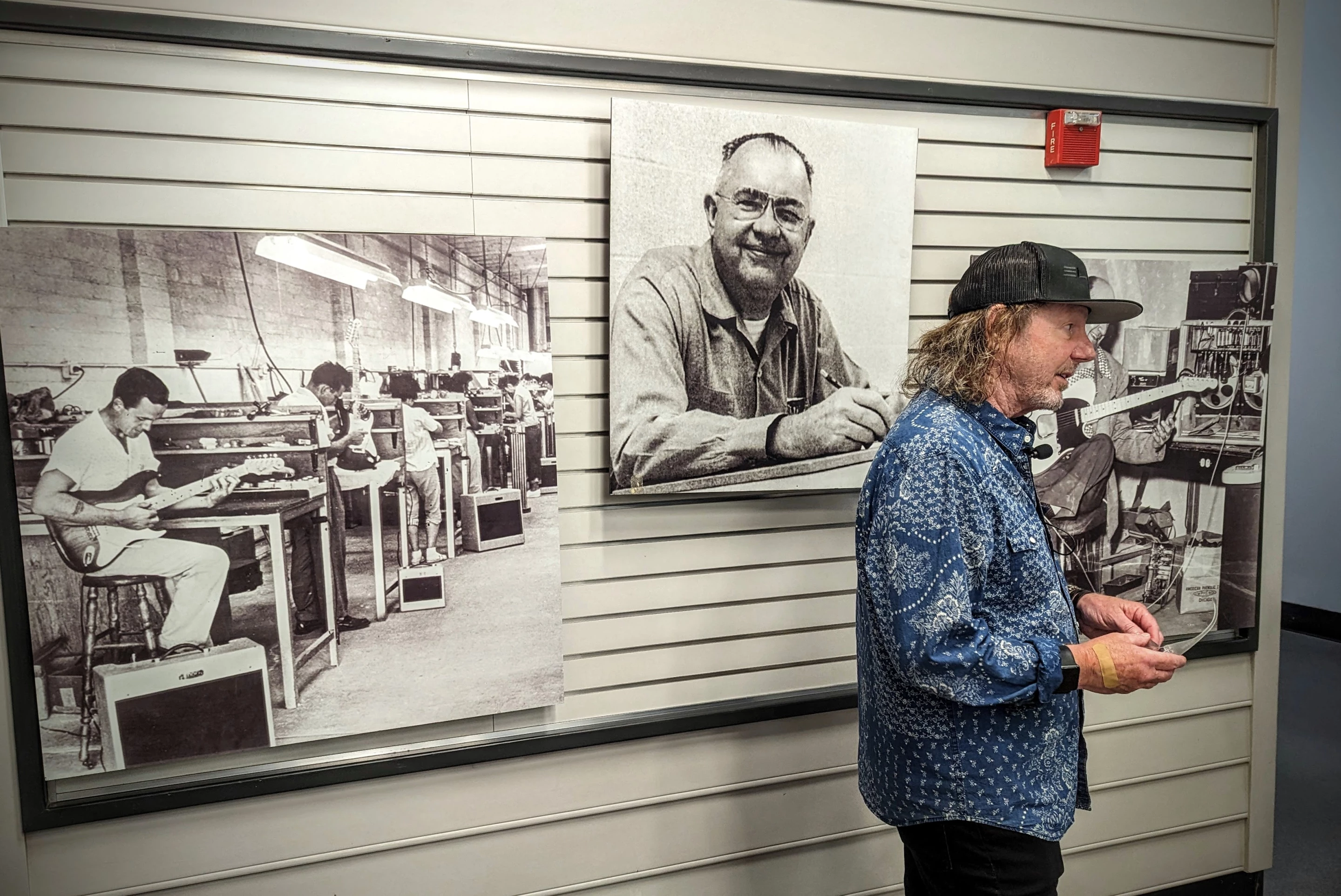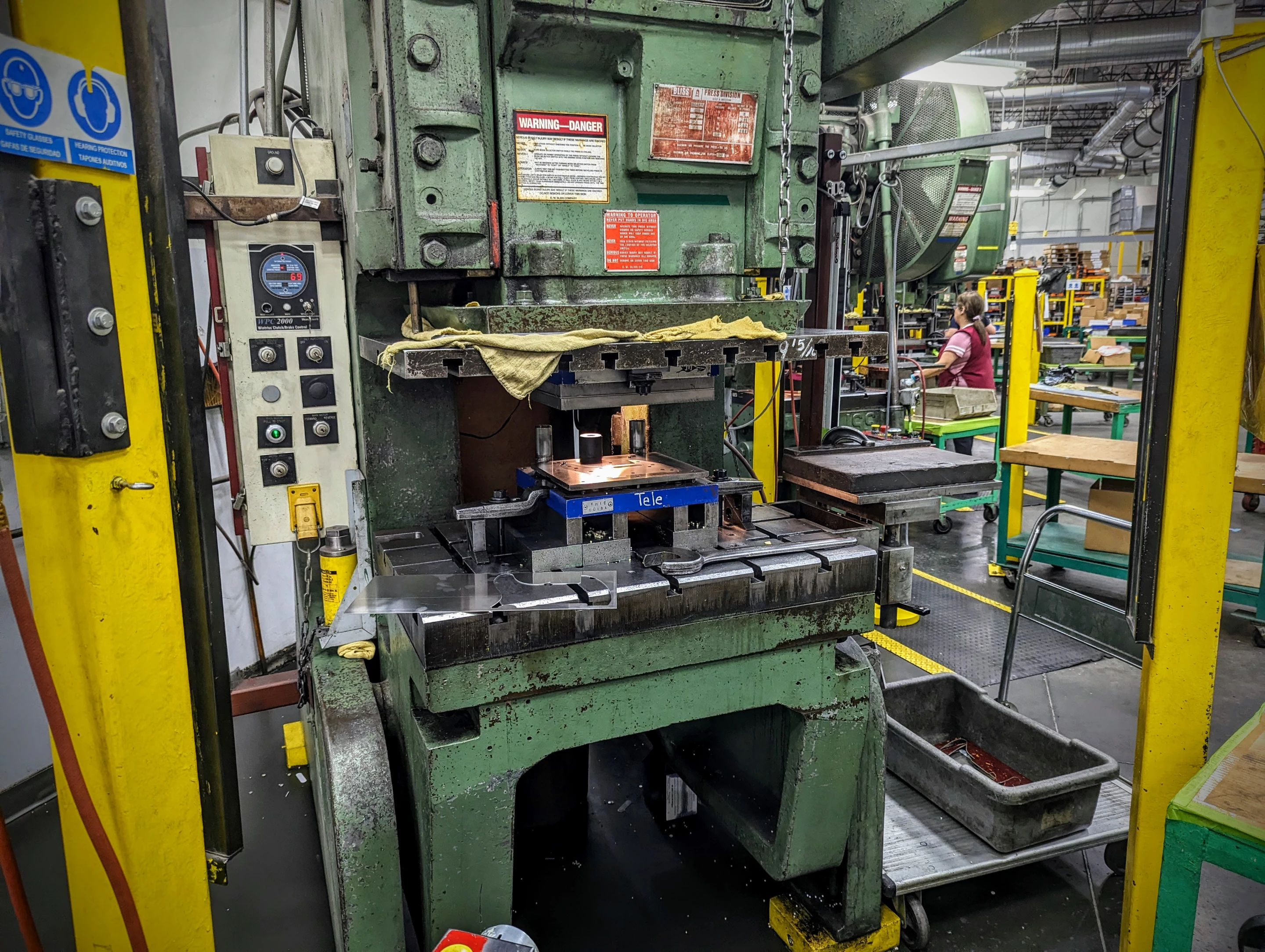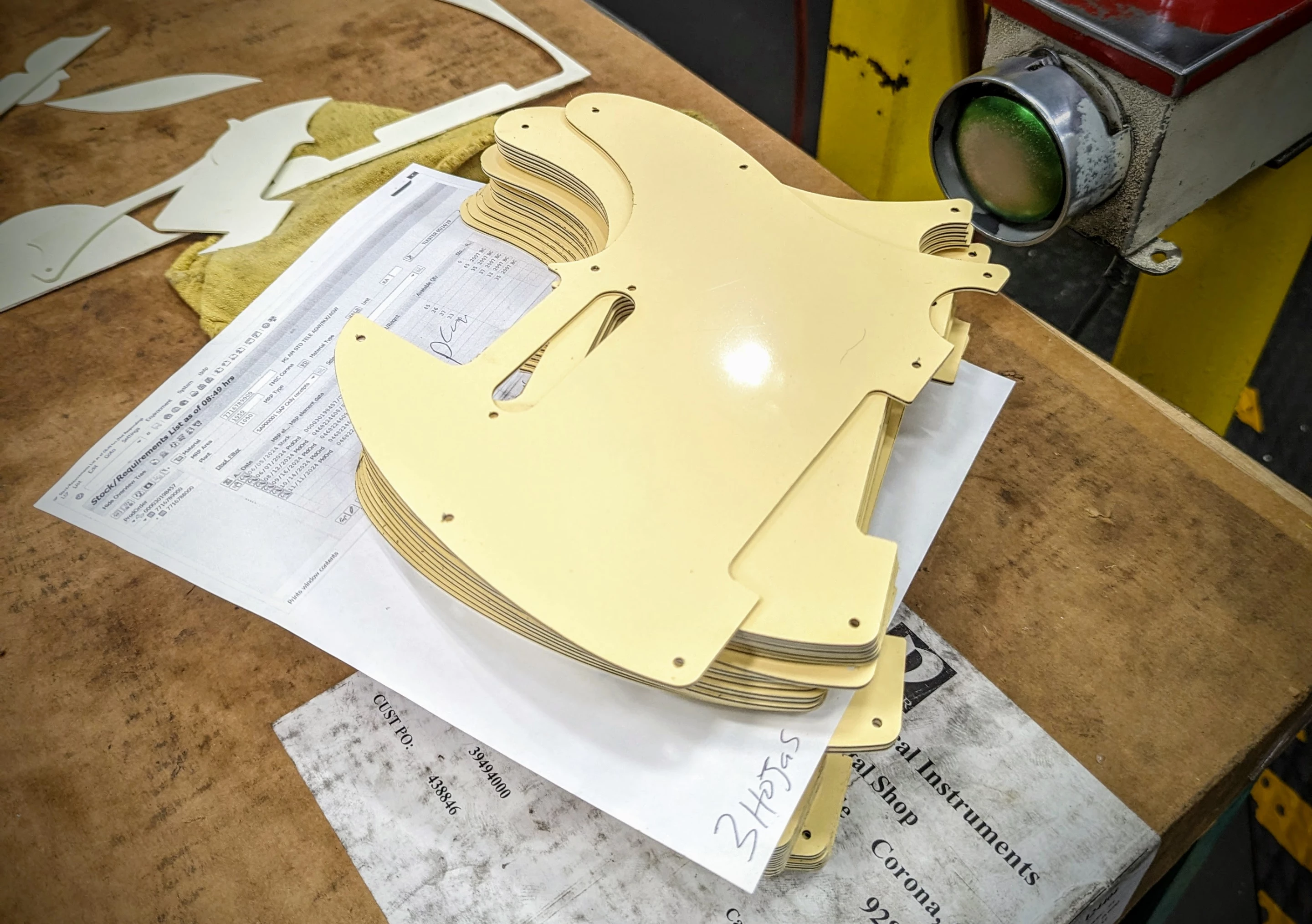Leo Fender's first solid-body electric guitar design, penned in the late 40s, was an absolute plank of a thing. You could row a boat or dig a hole with a Telecaster; heck, you still can, since they remain among the most popular designs in the world. It was a hole-in-one the first time he stepped up to the tee, especially for a man who famously never played guitar himself.
But Fender's follow-up, launched in 1954, exerted even more leverage on history, unlocking new sounds that have reverberated through the decades. As much a piece of art as functional design, the Strat took some of the Tele's suggestive curves and rounded off all the edges.
Comfort carves made room for a player's belly and forearm, but they also rhymed somehow with the gorgeous automotive designs of the day. Its asymmetrical twin horns gave it echoes of the flame job you might see down the side of a hot-rodded Mercury. The Stratocaster is absolutely one of the icons of 1950s design.

"Against the pickup truck of a Telecaster, yeah, this is a sports car," says Fender's Juston Norvell, VP of Product, welcoming me to head office in Los Angeles on a pilgrimage of sorts. "When the Tele first showed up at a trade show, I mean, guitars had carved tops like violins, and luthiery, and binding, and the Tele was this crude, utilitarian plank with screws and plastic ... By the time the Strat came, it was so much more refined with its curves."
"But," he laughs, "people still said it looked like it was from outer space."
Launching in the two-tone sunburst color that remains iconic, the Strat soon pioneered the automotive-inspired paint jobs that became part of its legend. This wasn't your grandaddy's arch-top, there was rebellion and revolution in those shapes and colors. When the Strat finally got some big-time TV exposure thanks to Buddy Holly putting one front and center on The Ed Sullivan Show in 1957, sales started to snowball, in a roll that's yet to end even 70 years later.
The Strat sound
Neither Holly nor Fender himself had any idea what this three-pickup guitar would go on to achieve sonically. Rock 'n' roll was still wearing suits and bow ties, turning up on parents' doorsteps asking daughters out on ice cream dates. Amps were played pretty clean most of the time, the gentle 'tremolo bridge' had yet to be recast as the wild, feedback-screaming 'whammy bar,' and the three-way pickup selector switch wasn't designed to get jammed in between positions.
But when it did, it activated two pickups at once. And their two signals, out of phase, would interfere destructively with one another, creating new electric sounds even further away from what acoustics made. You can access these iconic out-of-phase tones (think Hendrix, SRV, Mayer) on your Strat today by going to positions 2 and 4 on your switch. They're integral parts of the legendary sonic palette people keep coming back to this guitar for. But for decades, the only way you could get 'em was by jamming your switch halfway, hacking something out of the Strat that was never designed into it.
"Part of the reason it's become this timeless thing," muses Norvell, "is because so much of it was just right. It wasn't intentional. It was built to be a Spanish guitar – it was even called a Spanish guitar! It was built to sound clean. It wasn't built for the delay effects that would come, the fuzz tones, the distortion ... Jimi Hendrix at Woodstock? That was the furthest thing from Leo Fender's mind in '54, he had no idea the guitar could do that!"
A trip to the American Fender factory
At Fender's storied USA factory in Corona, California, I join a small gaggle of Australian and Japanese journalists on a walk through the entire manufacturing process, led by the last person on staff who worked with Leo Fender himself. Advisor Mark Kendrick started at Fender some 48 years ago.
"The first task they put me on was threading truss rods," Kendrick tells us. "And he came out and corrected me very gently, showed me the proper way to do it; I was getting them cross threaded ... In my personal experience, he was very quiet, very driven, he'd work endless hours, every day, all day."

While Fender gets most of the kudos for the Strat, Kendrick passionately disagrees. "It was everybody," he says. "It was Ray Lanham, it was Bill Carson, it was Alvino Ray. It was guys who later worked with Fender, like Gene Fields and Freddie Tavares and Ernie Ball, who hung out at the club where Leo would take his amplifiers and guitars to get feedback. All these people provided input, and there were many others."
Yes, the same Ernie Ball that created the eponymous string company that went on to employ Leo Fender in a later stint under Music Man – and which made the strings Eric Clapton used on his famous "Blackie" Strat. Not to mention the strings John Mayer used on his own black Strat. Mayer's now endorsing Paul Reed Smith's PRS guitars, and sounding amazing, but he made his name as a legit guitar hero on that beat-up black Fender, and to my ear he's never drawn more iconic tones out of anything since.
"The Strat wasn't solely Leo," says Kendrick. "A lot of people don't understand that Leo had a 50/50 partner in Donald D. Randall, who named every Fender product except the Precision Bass. In 1950, it was the Broadcaster, because most people had radios. That became the Telecaster, because televisions were taking off.
"And the Stratocaster? Well, that was because of all the people that came from the dust bowl out to California to work in the aeronautics industry. McDonnell Douglas, Boeing, Lockheed – there were jobs out here. And Don Randall was an avid pilot ... Stetson was making hats called Stratoliners, it just fell into that kind of area."
Kendrick leads us through the deafening chaos of the manufacturing floor, starting out at a great pile of slabs of wood. "Fender was the first to make a modular guitar out of dimensionally available lumber," he says with tired admiration, slapping a sawdusty board. "And the designs are so forgiving that they work with metric lumber supplies, as well."
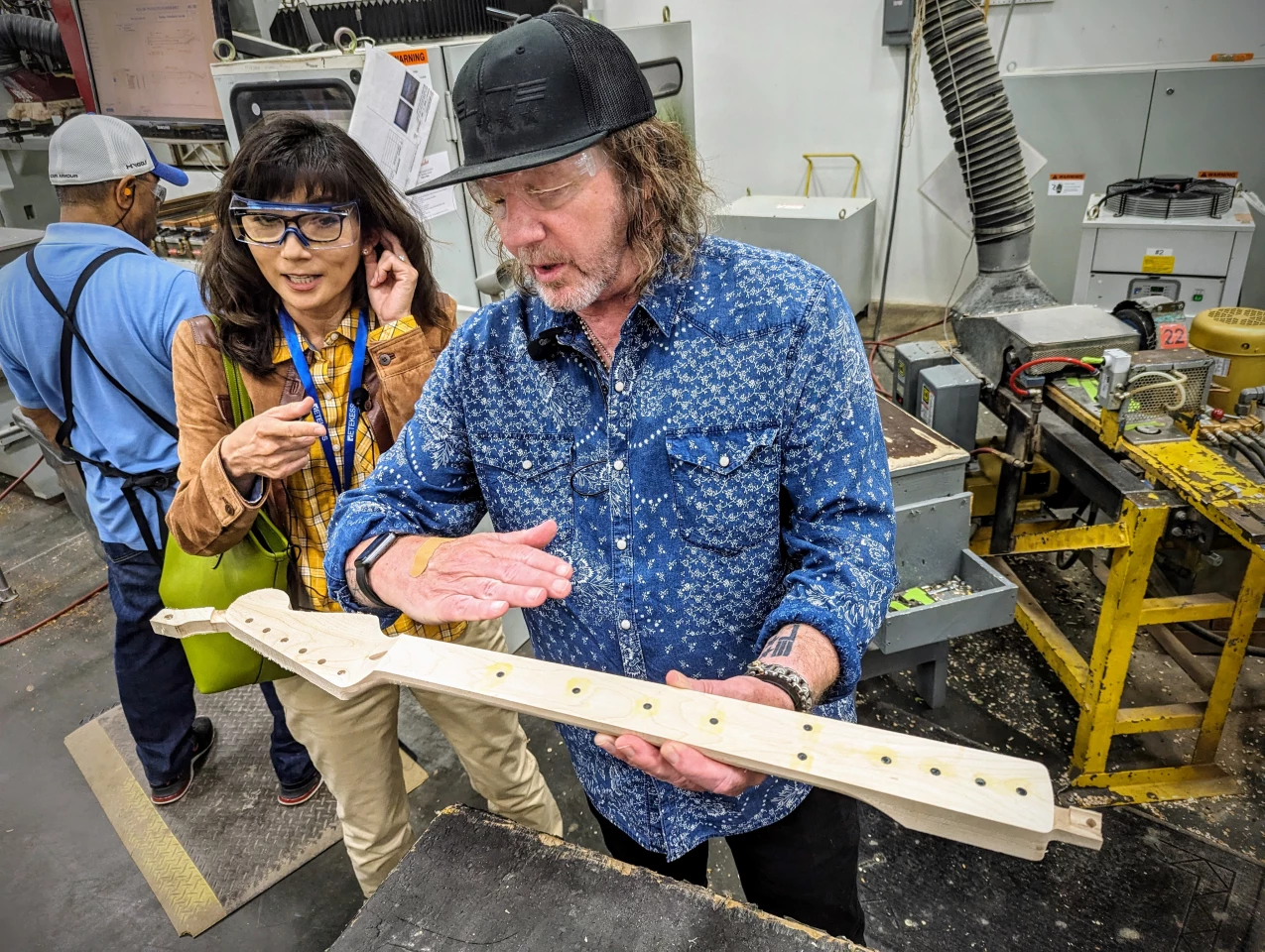
In 2024, of course, Fender isn't tracing designs with a pencil and cutting them out by hand on a bandsaw. The neck blanks and guitar bodies are precision-cut in CNC machines before most of the assembly work begins. But I'm genuinely surprised to see just how painstakingly manual the project is from there on; every standard Fender USA guitar passes through dozens of sets of hands by the time it's done.
And the brief doesn't appear to be uniformity, either, which is odd for a modern manufacturing operation. "Sanding," says Kendrick. "Sanding is the key to what makes a Fender a Fender. The human touch." The guys on the sanders and buffers can't hear him; the noise is furious and they're wearing ear plugs and face masks, but a couple look up, wink and grin as we pass.
"That personal variation in sanding techniques," says Kendrick. "That's what makes them feel different in the hands. That's why you should pick up several Fenders and see which one feels just right for you."
The mood is familial, and the predominant language is clearly Spanish. We meet several people who have worked at this factory for more than 20 years. Others whose parents worked here too. The whole factory crew gets together, they tell us, to party and have 'band jams' once a year. These events have become so big in recent times that the last one featured no less than 22 employee bands, across two stages, headlined by CEO Andy Mooney's own ensemble. Sneaking my way into one of these events, I decide, needs to go on my bucket list.
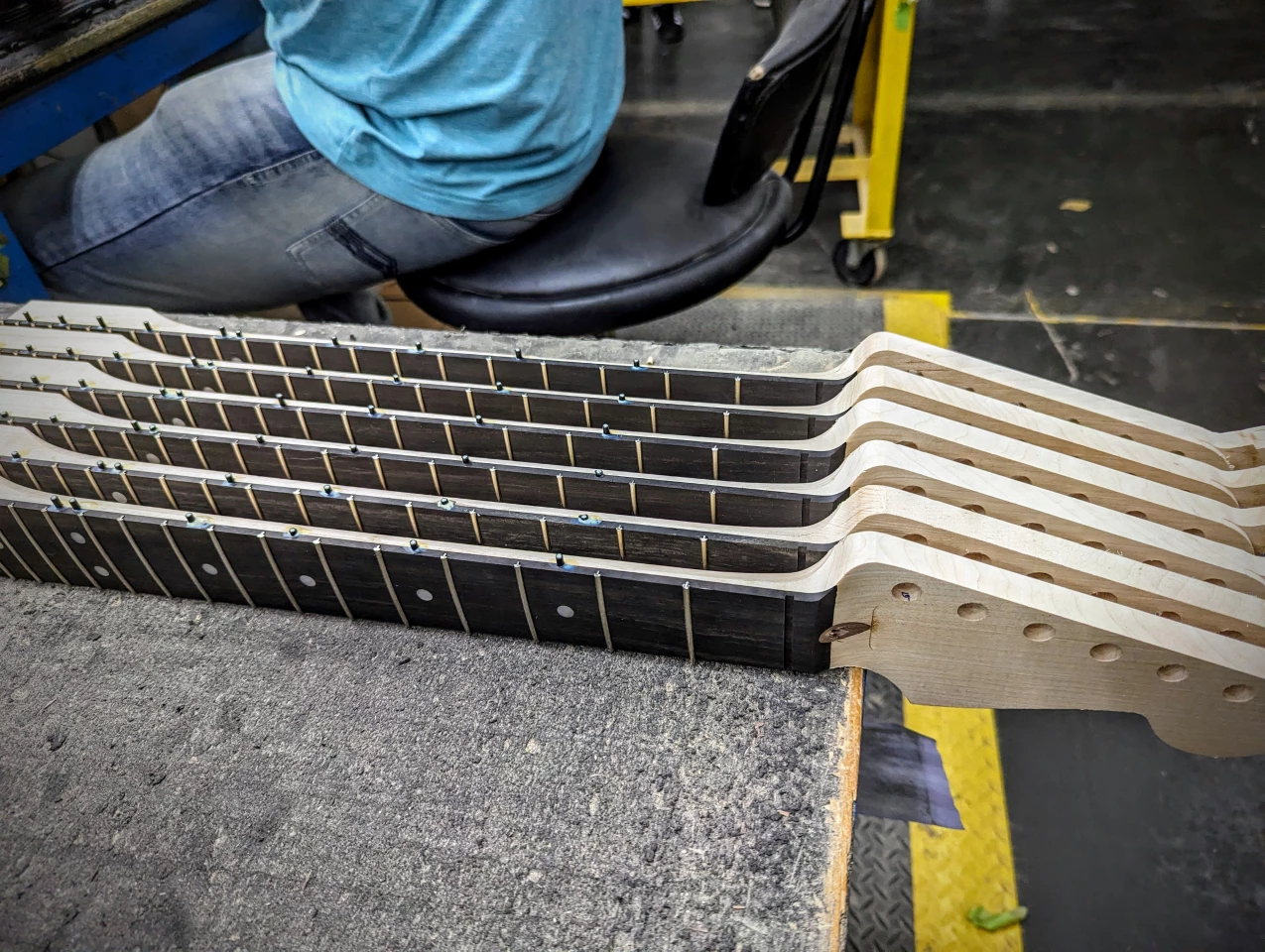
We walk past a row of maple necks with rosewood fingerboards laid on, the side inlays still protruding from the wood, and I think of the thousands of man-hours that have been spent on guitar forums debating the tonal merits of maple vs rosewood fretboards. "Why the decision to add an extra rosewood layer," somebody asks Kendrick. "Guys were complaining their necks were getting dirty," he replies.
One neck I notice that won't be getting dirty is the one attached to an unassuming-looking Strat hanging on the wall in the Custom Shop lounge. It's got great scalloped-out gouges dug into the wood between massive jumbo frets, so your fingers simply never touch the board, and the strings rub against nothing but metal. It's the signature model of Swedish neo-classical metal shred fiend Yngwie Malmsteen, who plays single-coil Strats through ultra high-gain Marshall stacks at the speed of light, somehow channeling Paganini's smoking violin in the process.
Good lord, this thing feels different to play than a vintage or modern Strat. It encourages all sorts of bad behavior, like gratuitous bends and mile-wide vibrato. At the same time, it frequently slaps your fretting hand, by sending notes out of tune the second you press too hard on the strings. A fascinating thing to play with, but back to the factory floor...
Toward the end, we go through the metal shop, which makes everything from bridges and saddles to string trees and tremolo arms. "Listen to that," says Kendrick. "These punch presses were Leo's favorite industrial sound." These machines, many of which have been stamping Fender parts with the same dies since the company's earliest days, also punch out the plastic pickguards and backplates, and they do make what I must agree is indeed a satisfying clunk and hiss.

We pass endless rows of drying bodies, racks of necks, tubs full of loaded pickguards of every imaginable specification. After going through the paint room, hundreds of guitar bodies are hung from the rafters of the factory for days at a time, depending on their paint spec and how long it takes to cure.
The further we go, the more complete the guitars look, until we reach the end of the line, and look out over vast racks of complete guitars and basses, ready to be laid in their cases and sent out. It's an overwhelming experience seeing them go from wooden planks to these gleaming, brand-new instruments, full of hope and infinite musical potential.

But gleaming and brand new is not the end of the process for Fender's top-shelf gear. That stuff needs to roll out looking faded, chipped, dented, scratched and beat up.
Fender's Custom Shop and the Relicing process
By the time Stevie Ray Vaughan took the stage at Montreux in 1982, his '59 Strat was well past legal drinking age and had already lived a full life on the road; man, if that thing could tell its stories. SRV preferred heavy-gauge, high-tension strings, and spent much of his time beating up on them like they owed him money, to bring out the trebles needed for his signature piercing, snarling Texas blues tone.
The sheer fury of his playing over the years tore through the nitrocellulose lacquer on the guitar's body, scratching it down to bare, tortured wood. And this has become a bit of a look; John Frusciante, Philip Sayce, Rory Gallagher and John Mayer are among many famous slingers of heavily-worn, beat-up Stratocasters over the years.
Which leads to a curious facet of the guitar world: some of the most expensive guitars Fender makes (and it's not alone in this) are pre-beaten up in the factory's storied Custom Shop – carefully rubbed, scratched, worn, aged and abraded by razor blades, heat guns and scads of other torture implements.
All this, so they can roll right out the factory door looking and feeling like they couldn't possibly be brand new, with tastefully checked and shrunken paint that looks like it's been left under hot stage lights for decades, necks that feel like a comfy old pair of jeans, and fretboards with finger marks worn into the wood, so they look like you've played the same 12 songs on them non-stop since Reagan was president.
We're not allowed to photograph this 'relicing' process, but having seen it, I can tell you this: you could totally do it yourself. Go on, have a crack at it. Your guitar can only get more valuable in the process.

The best of the best: One Master Builder per guitar
If you must leave it to the professionals, the best of the best at Fender are the hallowed Master Builders, a crack team of individuals that'll build you exactly what you want – be it a replica of your favorite artist's guitar, or something purely from your imagination, or something closer to standard – but with a single absolute legend of a craftsman responsible for the entire process.
Like Dennis Galuszka, helicopter pilot, drummer and former cabinetmaker, who joined the Custom Shop team in 1999 and took just eight months to be promoted into the pantheon of Master Builders. He's since built guitars for Paul McCartney and Sting, among countless others.
"They needed someone with a lot of woodworking knowledge," he tells me in his small, partitioned-off office. "And coming from the cabinet shop, I did that right away. Early on, they'd kind of beat up on me for, like, double necks, or really oddball stuff, because I'd just jump in the old-school way and make the damn thing. If you're only building one, I can build templates and have it in paint faster than these guys can write a CNC program, it's just easier for me.
"There's a lot of tricks we all employ to make a Master Built guitar feel more expensive – because it is, and it's scary buying these things sight unseen, I get it. It's incumbent upon us to really spend time on the areas that'll connect with the player.
"For me, that's the neck. It has to feel amazing. I have a fingerboard edge roll that's a bit different to the other guys. You know how the fret ends can feel like little melted bits of solder? You don't feel anything when you grab my necks.
"And things like loading the truss rod with a little tension before I dress the frets. It tightens it a bit like a drum head, so you're gonna get a little more ring or sustain out of it, it'll probably be more stable through weather changes ... If you ever put a stethoscope on a guitar, the loudest part is that headstock tip – man, it's really loud up there! So that transfer of energy is pretty important, you gotta go through the neck and make sure the whole thing works as its own mini orchestra. And it does matter!"
"And then there's the relicing process. It's not a huge thing tonally or anything," says Galuszka. "But you want it to look real. We're all trying to keep up with Dale Wilson, one of the other builders. His relics are impeccable. We know what he's doing and still none of us can replicate it!"
So how does a master woodworker feel about making these gorgeous instruments and then immediately having to scratch and beat them up? "You know, honestly, I don't wanna sound dismissive, but I really don't care," he replies. "The thing that really keeps me in love with this job is making what you want. Pulling something out of your brain and making exactly what you had in mind, that's what I love. And the reaction, when you make something for an artist, especially an artist that plays really well, and you get to hear them do their thing? That's what I love."
Hard to kill, easy to modify
"Some of the relic thing is the mythology of what that represents," muses Justin Norvell back at head office. "But it's built off the fact that Fenders are constructed in a way where they just don't break. There's a lot of guitars that are more delicate. The tops can buckle, the headstocks can snap off. But if you watch videos of Mike McReady or Stevie Ray Vaughan, they're throwing the guitar, they're dragging it around, and they pick it up and it lives to fight another day.
"Leo Fender was a repairman, a service guy. So he always built everything so nothing's more than a few screws away. He had the foresight of modularity back in the 50s ... And that created this whole maker culture of modifiers, switching pickups, changing knobs, trying different hardware, messing with the wiring – you could do this at home!
"And that sometimes feeds back into our designs, if a mod is taking off and starting to resonate with people, well, let's do a guitar that way! Like the Lone Star Strat back in 1996 – that was the first Stratocaster with a humbucker bridge pickup on it from our factory. But people had been chiseling out their Strats and putting humbuckers in them for decades. Now, about a quarter of our Stratocaster sales are humbucker-equipped guitars."
I ask Norvell exactly how many different types of Fender Stratocaster you can buy in 2024. "Right now, I think it's just under 100," he says. "It might be a lot easier if there were just, like, four Strats, but each one actually serves a type of player, or a style – because it's so broad, from country to punk, blues, funk... Nile Rodgers to Jim Root from Slipknot, all playing Stratocasters!"
Vintage vs Modern Strats
Even just within the American-made SSS Strats, the differences are massive. Comparing the American Vintage II 1957 model to the 70th Anniversary American Professional II, as I look at them now in my home studio, the shape and layout of these two instruments are so close, but the feel and tone are worlds apart.
The AVRI2 '57's 10-gauge strings sit high above the 7 1/4-inch radius maple fretboard with its 21 low-profile vintage frets. The pickups are lower-output, with a fuller tone, and this is a guitar that fights back a little. You've got to dig right in and work it harder to get what you want.

The flame-topped AmPro2, on the other hand, rocks 9-gauge strings, the action set lower over the 9.5-inch radius rosewood fretboard with its 22 modern narrow-tall frets. The pickups are higher-output, and the tone is tighter, quackier and more scooped. This is an absolutely effortless guitar to play.
These two Strats are worlds apart – they both sound amazing, but you'd pick them up for different reasons and different songs. That's part of the fun when you dive into the rabbit hole of Stratocasters; no collection can ever be considered complete, and they've all got their own personalities.
Personally, if I had my run of the Mod Shop to put my own dream guitar together, it'd probably end up looking very much like the American Pro II; it's a truly excellent guitar, from the two-point trem to the flame maple top, nicely carved heel cutaway and the locking tuners. But man, I keep coming back to that '57... It makes me work harder, but that's part of the charm.
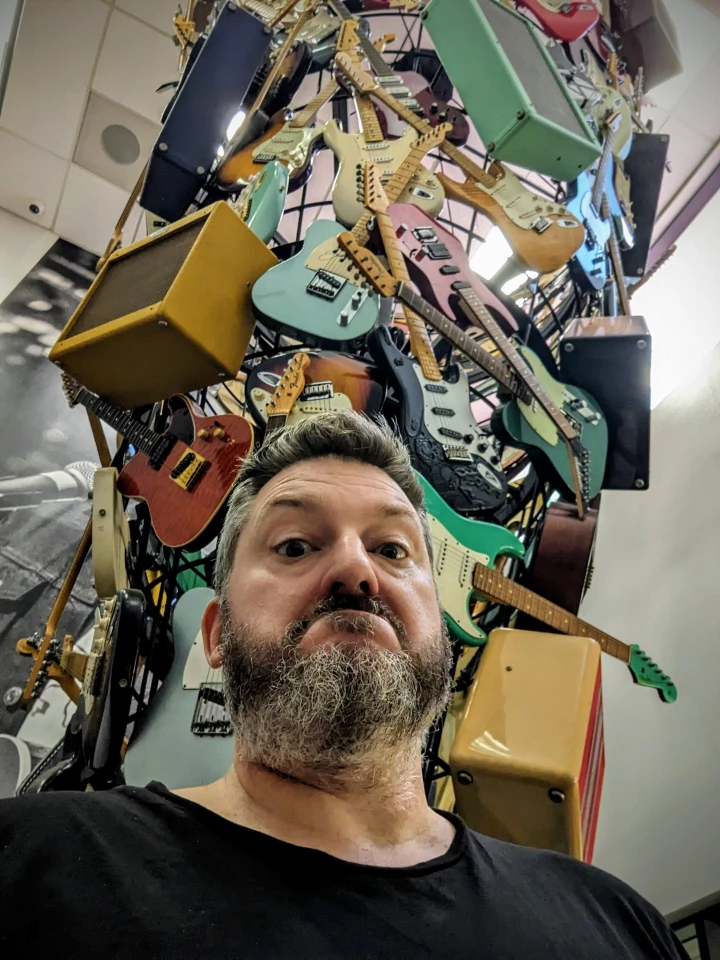
A hell of an achievement
Leo Fender and his team have made indelible contributions to the arts. The list of innovative Fender products that have gone on to be generational icons is staggering. Telecaster, Jazzmaster, Jaguar, Twin Reverb, Deluxe Reverb, Bassman, Princeton, 5E3 Tweed, P-Bass, Jazz Bass ... You've seen these names behind just about everyone who's been anyone since the dawn of rock 'n' roll.
And towering over all these giants, the mighty Strat. It remains enticing and intimidating in equal measures to me. It's so easy to enjoy in all its many forms, there are so many rabbit-holes of tone and style to go down in this one machine, and it becomes unnervingly articulate the better you learn to use it.
But the better I get, the more those iconic tones start to taunt me. So many greats have made this guitar their own that I'm forever hearing hinted echoes of their work through my own amp, snapping me out of my reverie as I notice how much I pale in comparison. That's part of the weight you take on your shoulders when you pull a Strat out of the rack: if you're not sounding like the greatest that ever did it, it's not the guitar's fault!
As a legacy, though, what a gift to music. And while the team was invaluable to the process, there's one fella's name on the headstock. I reckon Leo Fender could rest easy if the Stratocaster was his only contribution. There are surely better guitars some 70 years after its debut, but there are none greater.

"The last day before he passed away, he was at the shop," says Mark Kendrick. "Clarence Leo Fender, his laboratory. He went home and told his wife, 'I think I've done all I can do for the electric guitar.' And by the next morning, he had passed on, at 91."
Source: Fender
Thanks to the Fender team for flying me out and hosting me at the USA factory. An unforgettable experience!




